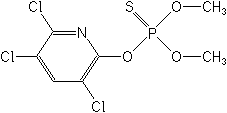-
Common NameChlorpyrifos-methyl
-
中文通用名甲基毒死蜱
-
IUPACO,O-dimethyl O-3,5,6-trichloro-2-pyridyl phosphorothioate
-
CASO,O-dimethyl O-(3,5,6-trichloro-2-pyridinyl) phosphorothioate
-
CAS No.5598-13-0
-
Molecular FormulaC7H7Cl3NO3PS
-
Molecular Structure
-
Category
-
ActivityInsecticide, acaricide
-
PremixLambda-cyhalothrin+chlorpyrifos-methyl
Deltamethrin+chlorpyrifos-methyl
Beta-cypermethrin+chlorpyrifos-methyl
Premix Parters: 2,4-D
-
Physical PropertiesMolecular weight:322.5; Physical form:White crystals, with a slight mercaptan odour. Density:1.64 (23 °C); Composition:97% pure. Melting point:45.5-46.5 °C; Flash point:182 °C (COC); Vapour pressure:3 mPa (25 °C); Henry constant:3.72×10-1 Pa m3 mol-1 (calc.); Partition coefficient(n-octanol and water):logP = 4.24; Solubility:In water 2.6 mg/l (20 °C). In acetone >400, methanol 190, hexane 120 (all in g/kg, 20 °C).; Stability:Hydrolysis DT50 27 d (pH 4), 21 d (pH 7), 13 d (pH 9). Aqueous photolysis DT50 1.8 d (June), 3.8 d (December).
-
ToxicologyOral:Acute oral LD50 for rats >3000 mg/kg, mice 1100-2250, guinea pigs 2250, rabbits 2000 mg/kg. Percutaneous:Acute percutaneous LD50 for rabbits >2000 mg/kg,guinea pig 2250 mg/kg, rats >3700 mg/kg. Non-irritating to skin and eyes. Inhalation:LC50 (4 h) for rats >0.67 mg/l. ADI:(JMPR) 0.01 mg/kg b.w. [1999].
-
Environmental ProfileEcotoxicology: Algae:EC50 (72 h) for Selanastrum capricornutum 0.57 mg/l.Bees:Very toxic to bees. LD50 (contact) 0.38
mg/bee.Birds:Acute oral LD50 for mallard ducks >1590, bobwhite quail 923 mg/kg. Dietary LC50 (8 d) for mallard ducks 2500-5000 mg/kg.Daphnia:LC50 (24 h) 0.016-0.025 ppm.Fish:LC50 (96 h) for rainbow trout 0.41, bluegill sunfish 0.88 mg/l.Worms:LC50 (15 d) for Eisenia foetida 182 mg/kg soil. Other aquatic spp.:Toxic to crustaceans. LC50 (36 h) for crayfish 0.004 mg/l. Environmental fate: Animals:In rats and other mammals, following oral administration, rapid metabolism occurs, the principal metabolite being 3,5,6-trichloropyridin-2-ol. Excretion is principally in the urine.Soil:In soil, undergoes microbial degradation to 3,5,6-trichloropyridin-2-ol, which is subsequently degraded to organochlorine compounds and CO2; DT50 1.5-33 d, DT90 14-47 d, depending upon soil type and microbiology. WATER SOLUBILITY: Poor solubility, 4 mg/l at 24°C. -
Transport InformationSignal Word:CAUTION; Hazard Class:III (Slightly hazardous)
Porduct NewsMore
EU ban chlorpyrifos and chlorpyrifos-methyl
Chlorpyrifos Chlorpyrifos-methyl
Sapec Agro launches new insecticide molecule in Portugal
Related CompaniesMore
Country: India
Cypermethrin Permethrin Alpha-cypermethrin Fenvalerate Lambda-cyhalothrin Chlorpyrifos-methyl Ethion Phenthoate Bifenthrin Thiamethoxam
Country: India

 0
0 Subscribe
Subscribe
